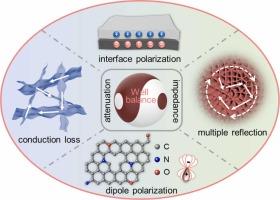Radially Channel Engineering for N/O Co-doped Carbon Sphere towards High-performance and Multiband Microwave Absorption
IF 6.3
2区 材料科学
Q2 CHEMISTRY, PHYSICAL
引用次数: 0
Abstract
Although spherical carbon exhibits excellent dielectric loss capability, its practical application is hindered by impedance mismatch and high filler content, which are the main reasons for unsatisfactory performance. To overcome these limitations, N/O Co-doped carbon sphere with radially porous configuration (RPCS) was fabricated via a self-templated route. The in situ doped heteroatoms can provide dipole polarization relaxation, while the radial pores are beneficial for lightweight, low dosage and moderate impedance. Through investigation, it can be concluded that varying the preparation temperature can effectively adjust the ultimate absorption properties. As the optimal sample, the RPCS-800 delivers the absorption intensity exceeding -40 dB in multiple wavebands. In particular, the strongest absorption of -56.5 dB is realized at a thin thickness of 1.85 mm, accompanied with an effective absorption bandwidth of 5.5 GHz. This outstanding electromagnetic protection characteristic is further validated through the CST simulation, with a maximum RCS reduction of 25.9 dB m2. The obtained RPCS material shows obvious merits compared to the previously reported carbon-sphere based absorbers. Therefore, this study may provide new inspiration for the development of lightweight and multiband spherical carbon absorbing materials.

面向高性能多波段微波吸收的N/O共掺杂碳球径向通道工程
尽管球形碳具有优异的介质损耗性能,但阻抗失配和填料含量过高阻碍了其实际应用,这是其性能不理想的主要原因。为了克服这些限制,采用自模板方法制备了具有径向多孔结构的N/O共掺杂碳球。原位掺杂的杂原子可以提供偶极极化弛豫,而径向孔隙则有利于轻量、低剂量和中等阻抗。研究表明,改变制备温度可以有效地调节其最终吸收性能。作为最佳样品,RPCS-800在多个波段的吸收强度超过-40 dB。其中,-56.5 dB的最强吸收是在1.85 mm的薄层上实现的,有效吸收带宽为5.5 GHz。通过CST仿真进一步验证了这种出色的电磁保护特性,最大RCS降低25.9 dB m2。与先前报道的碳球基吸收剂相比,所获得的RPCS材料具有明显的优点。因此,本研究可能为轻量化、多波段球形吸碳材料的开发提供新的启示。
本文章由计算机程序翻译,如有差异,请以英文原文为准。
求助全文
约1分钟内获得全文
求助全文
来源期刊

Journal of Alloys and Compounds
工程技术-材料科学:综合
CiteScore
11.10
自引率
14.50%
发文量
5146
审稿时长
67 days
期刊介绍:
The Journal of Alloys and Compounds is intended to serve as an international medium for the publication of work on solid materials comprising compounds as well as alloys. Its great strength lies in the diversity of discipline which it encompasses, drawing together results from materials science, solid-state chemistry and physics.
 求助内容:
求助内容: 应助结果提醒方式:
应助结果提醒方式:


